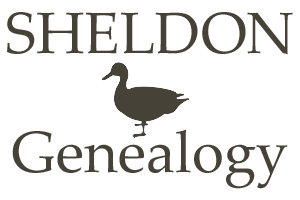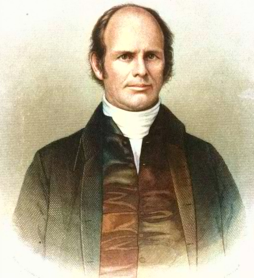Research in England 2015-2017
Results from Y-chromosome DNA studies within the Sheldon Surname Project at FTDNA concluded that the five progenitor families (perhaps four) descend from two genetic families.
- Group A: Godfrey, John of Providence, and Richard
- Group B: John of Narragansett and Isaac
Further, testing of Sheldons in England also concluded that Group A was a match to Sheldons who descend from Derby, England. A branch of this family moved south to Staffordshire and produced Gilbert Sheldon, Archbishop of Canterbury. Testing of Sheldons in Durham, England also suggest that they are of this group although the connection on paper has not yet been made.
In an attempt to narrow the playing field in our pursuit of finding the English origins of Group B, we did an analysis of Y-chromosome matches to Group B testers that were a bit further afield genetically (families that were as close to the Group B Sheldons as possible while being connected prior to the period of surname adoption). We found that several matches had connection and/or origins to County Devon in the southwest of England. This part of England is also the place of origin of several other colonial American families, lending more credence to the hypothesis that Group B may have originated in this area – which also includes Cornwall and Somerset.
Oct 2017 Trip to Devon, England
Dale Sheldon and Kelly Wheaton’s embark on a research trip to County Devon, England in an attempt to prove or disprove our theory. Preliminary research showed that an early Sheldon family may have originated around the modern area of Shaldon also spelled Sheldon near Teignmouth, with the Sheldon manor house (now a private religious retreat) being in nearby Doddiscombsleigh. Origins of the manor are with the “de Shildon” family in the 11th century. With their surname literally meaning “of Sheldon”, it appears that this family originated with a gentleman from Shaldon who then named his Manor house after his surname and place of origin.
In digging into the archives at the Devon Heritage Center we quickly found that the County was largely void of the surname Sheldon. The only Sheldons in the book of Wills were more recent with clear origins from other parts of the country such as Warwickshire and Staffordshire. The only 17th century Sheldon that could be found was in relation to a land record connected to the Petrie family – confirming that this was a branch of the Warwickshire Sheldons. This line was descended from the Beoley Sheldons that moved on to Spetchley and then Manston in Dorsetshire.
The only promising find that could possibly related to the 11th century “de Shildon’s” was the March 1604 Will of “Thomas Eastbrooke, alias Shilstone” of Doddiscombsleigh. This Thomas died without a wife or children and instead listed his three brothers – William, John, and Richard. The names William, John, and Thomas are all very common in the Group B Sheldons. William and John are, of course, generally common across England, but Thomas was not as common during the period. However, further research of this family suggested that another branch of this family moved up to nearby Hathersleigh and founded the hamlet of Shilstone. Here we also find the 1626 Will of “widdowe Christian Shilston”, she mentions a brother-in-law Robert Shilstone and Cousin Gilbert Shilstone. There was also a 1661 marriage of Thomas Shilstone, alias Eastabrook, in Hathersleigh. So, the question was, were the Shilstons of Devon, the same as our Sheldons? Unfortunately, this seems unlikely. To date, the surnames Shilstone and Estabrooke (and their variations) have not been found among any of the Y-chromosome DNA matches of the Group B Sheldons. The 1911 Census of England has only 40 people named Shilstone, all being from southern England and the majority from the southwest. There is still a possibility that no modern male descendant has tested – but generally this is a stretch.
English Research 2017-2019
At this point we largely ruled out the southwest of England as the origin of any modern Sheldon family – being that the ancient de Shildon family seemed to have died out shortly after they began evidence by the complete lack of Sheldon documentation in the southwest from the 13th to 16th centuries. If Group B didn’t start in Derby or Devon, then where? The surname “Sheldon” is unique in its etymological origin. Surnames like Smith, Thatcher, and Baker are occupational surnames that could have dozens upon dozens of independent origins across the country. But “Sheldon” is geographic and specific, making it rare. So, our preliminary research continued in search of alternate places of origin.
We found a previously overlooked Sheldon location in modern day Birmingham. (Note: had we had the earlier records above we would have realized this was a key Sheldon locale). The place of Sheldon was unincorporated a century ago, but Sheldon Hall (now a pizza place) persists. Research of Sheldons in this area found extremely early records and a history pre-dating the Norman Conquest. It had previously been assumed that all Sheldons in this mid-western region of England, including the counties of Staffordshire, Warwickshire, Oxfordshire, Worcestershire, and Gloucestershire – were all from the same family of Derby. This assumption was based on the confirmation that at least one Derby branch had migrated to Staffordshire. However, now finding this equally ancient Sheldon origin in Birmingham showed that this may not be the case. We then delved deeply into the various Sheldon lines in these counties and found that the majority of them were connected, and that they were extremely wealthy. No paper connection could be found between them and the Staffordshire/Derby Sheldons. In fact, when Gilbert Sheldon, Archbishop of Canterbury (the first of that line to rise to prominence) applied for his Coat of Arms, it was noted that it was only assumed that the Sheldons of Staffordshire/Derby were distant cousins of the Sheldons of Warwickshire. This distinction was made because the Coat of Arms of the Warwickshire Sheldons (now used by the Sheldon Family Association) had been established over a century before. As they could not find the connection between Gilbert and those arms, an only an assumption could be made, he was not allowed to use the arms exactly. Instead, the colors were reversed, and the bar became a chevron – leaving the three ducks (or sheldrakes) the same.
Aug 2018
Kelly Wheaton prepared and SFA mailed out recruitment letters to large list of Sheldons living in Birmingham and Warwickshire to see if we could recruit more DNA testers. This effort was largely unsuccessful. Most progress on recruiting new English testers has been through social media like Facebook.
Oct 2019 Trip – Warwickshire England
Dale Sheldon and Kelly Wheaton embark on their second research trip to England. Our goal this trip was to visit MANY Sheldon locations across the shires. In addition to a pizza dinner at Sheldon Hall and visiting the sites of lost Sheldon manor houses in Broadway, Weston Park, Spetchley, and others – we also visited the original Sheldon tapestries at the Bodleian Library at Oxford and the Council Museum at Warwick, as well as the Sheldonian Theater in Oxford named for the Archbishop. The biggest highlight was probably a Sunday service at the church at Beoley with its connected Sheldon Chapel containing the marble effigies and graves of several early generations of some of the wealthiest Sheldons in England’s history. Among the other Sheldon places visited: SHELDON arms embedded in a fountain wall at Wolford; St Martin’s Church Barcheston (Ralph Sheldon of the Sheldon tapestries); Sheldon Wine Company, Shipston on Stour; Sheldon Chapel at Beoley St. Leonards, Sheldon, Hall, Sheldon; St Giles Church Sheldon; Sheldon Cottage, Broadway, Part of Sheldon Manor Broadway, Broadway Church of St Eadburgha; talk on he SHELDON Tapestry at Bodliean Library. We photographed and documented as much as we could manage. A stop in at the Shakespeare Heritage Center didn’t yield any Sheldon information, but we did not have time to visit the Warwick Heritage Center. We were also unable to make it up to Bakewell, Derby as planned – as well as the nearby village of Sheldon related to Group A Sheldons.
Oct 2019 to present
Throughout 2019 and 2020 Dale Sheldon and Kelly Wheaton collaborated on further research into the midland Sheldons, too numerous to enumerate here. Dale conducted forward research of the Warwickshire lines in an attempt to locate possible modern descendants. DNA testing of these individuals has been inconsistent – although none have matched Group B, they also have not all matched each other. The two that did match each other (and not from the same immediate family), shows close matches to the MONTGOMERY family of Ireland and Scotland, suggesting that an NPE took place in that line in the 18th century. More testing is needed of Warwickshire Sheldons.
For our next trip we are looking to dive back into the archives. This time planning to spend time at the National Archives in Kew, and at the Warwick Heritage Center in Warwick. Other less likely points of origin in Norfolk and Wiltshire are also being pursued, but these seem unrelated. There is a possibility that the Group B Sheldons left with the Dorchester Group from Dorset which also demands more research.


